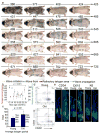Regenerative hair waves in aging mice and extra-follicular modulators follistatin, dkk1, and sfrp4
- PMID: 24618599
- PMCID: PMC4102635
- DOI: 10.1038/jid.2014.139
Regenerative hair waves in aging mice and extra-follicular modulators follistatin, dkk1, and sfrp4
Abstract
Hair cycling is modulated by factors both intrinsic and extrinsic to hair follicles. Cycling defects lead to conditions such as aging-associated alopecia. Recently, we demonstrated that mouse skin exhibits regenerative hair waves, reflecting a coordinated regenerative behavior in follicle populations. Here, we use this model to explore the regenerative behavior of aging mouse skin. Old mice (>18 months) tracked over several months show that with progressing age, hair waves slow down, wave propagation becomes restricted, and hair cycle domains fragment into smaller domains. Transplanting aged donor mouse skin to a young host can restore donor cycling within a 3 mm range of the interface, suggesting that changes are due to extracellular factors. Therefore, hair stem cells in aged skin can be reactivated. Molecular studies show that extra-follicular modulators Bmp2, Dkk1, and Sfrp4 increase in early anagen. Further, we identify follistatin as an extra-follicular modulator, which is highly expressed in late telogen and early anagen. Indeed, follistatin induces hair wave propagation and its level decreases in aging mice. We present an excitable medium model to simulate the cycling behavior in aging mice and illustrate how the interorgan macroenvironment can regulate the aging process by integrating both "activator" and "inhibitor" signals.
Conflict of interest statement
Figures





Comment in
-
The thinning top: why old people have less hair.J Invest Dermatol. 2014 Aug;134(8):2068-2069. doi: 10.1038/jid.2014.172. J Invest Dermatol. 2014. PMID: 25029319 Free PMC article.
References
-
- Blanpain C, Lowry WE, Geoghegan A, et al. Self-renewal, multipotency, and the existence of two cell populations within an epithelial stem cell niche. Cell. 2004;118:635–48. - PubMed
-
- Botchkarev VA, Botchkareva NV, Roth W, et al. Noggin is a mesenchymally derived stimulator of hair-follicle induction. Nat Cell Biol. 1999;1:158–64. - PubMed
-
- Brack AS, Rando TA. Intrinsic changes and extrinsic influences of myogenic stem cell function during aging. Stem Cell Rev. 2007;3:226–37. - PubMed
Publication types
MeSH terms
Substances
Grants and funding
LinkOut - more resources
Full Text Sources
Other Literature Sources
Medical
Molecular Biology Databases

